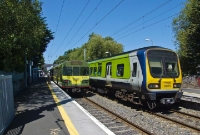Sydney Parade
Sidney Parade, located in Dublin City's southern suburbs, was first served by the railway as early as 1835 when the Dublin & Kingstown Railway constructed a station on Sidney Parade Avenue one year after the opening their line from Westland Row (Pearse) to Kingstown (Dun Laoghaire). By the 1860s, the D&KR had become the Dublin Wicklow & Wexford Railway, and this company upgraded Sidney Parade Station in 1862 by providing a single storey brick built station building on the up platform, and large waiting shelter on the down platform. A footbridge was also installed and a new 9-lever signal cabin was constructed at the north end of the station in 1871. Sidney Parade Station was closed by CIE in 1960, but reopened in 1972 with the expansion of Dublin suburban services. All the buildings survived demolition during closure and were utilised once again, accept for the footbridge which was replaced by Great Southern & Western style one once located at Sandymount. Today only the signal cabin is disused, though preserved, it closed in 1985 one year after the crossing gates were automated for the DART. The station is also nowadays signposted as 'Sydney Parade'.














